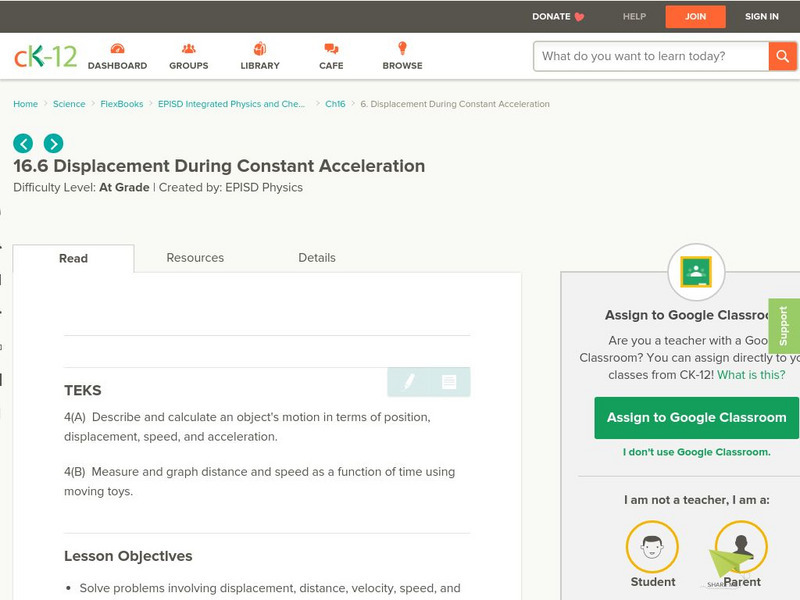Mathed Up!
Distance Time Graphs
If only there was a graph to show the distance traveled over a period of time. Given distance-time graphs, pupils read them to determine the answers to questions. Using the distance and time on a straight line, scholars calculate the...
Columbus City Schools
Speed Racers
Who wants to go fast? The answer? Your sixth-grade science superstars! The complete resource offers the ultimate, all-inclusive playbook for mastering the important concepts of speed versus time; distance versus time; and how...
Mr. E. Science
Motion
An informative presentation covers motion, metric system, conversions, graphing of coordinates and lines, speed, velocity, and acceleration problems, as well as mean calculations. This is the first lesson in a 26-part series.
InqueryPhysics
Interpreting Motion Graphs
Every movement in the world can be measured and even motionless objects can be significant indicators of movement. Focus on motion graphs that feature distance vs. time, speed vs. time, and positive and negative acceleration.
Edmond Public Schools
8th Grade Science Resource Book: Unit 2 - Physics
Get things moving with this extensive collection of physical science resources. Covering the fundamentals of measurement, graphing, lab safety, and experimental design as well as the specific scientific concepts...
Evergreen State College
Physics: Motion
My acceleration is downward at 9.8 meters per second squared. That means I'm falling for this physics of motion instructional activity. Once motion has been covered in class, give a instructional activity that offers multiple...
EngageNY
Searching a Region in the Plane
Programming a robot is a mathematical task! The activity asks learners to examine the process of programming a robot to vacuum a room. They use a coordinate plane to model the room, write equations to represent movement, determine the...
National Council of Teachers of Mathematics
Varying Motion
For this secondary mathematics learning exercise, high schoolers collect data based on a person’s motion. From this data, students create graphs comparing displacement, velocity, and acceleration to time. The five-page learning exercise...
Mathematics Vision Project
Module 6: Trigonometric Functions
Create trigonometric functions from circles. The first lesson of the module begins by finding coordinates along a circular path created by a Ferris Wheel. As the lessons progress, pupils graph trigonometric functions and relate them to...
Noyce Foundation
Truffles
Knowing how to scale a recipe is an important skill. Young mathematicians determine the amount of ingredients they need to make a certain number of truffles when given a recipe. They determine a relationship between ingredients given a...
EngageNY
Constant Rates Revisited
Find the faster rate. The resource tasks the class to compare proportional relationships represented in different ways. Pupils find the slope of the proportional relationships to determine the constant rates. They then analyze the...
Texas Education Agency
Texas Gateway: Objects in Motion
This resource provides flexible alternate or additional learning activities for students learning about the concepts of distance, speed, and acceleration.
BBC
Bbc: Gcse Bitesize: Motion
This lesson focuses on how to calculate average speed and distance traveled. It also explains how to convert different units of measure and provides a link to an assessment.
Khan Academy
Khan Academy: Simple Harmonic Motion: Find Speed, Velocity, Displace From Graphs
Practice finding speed, velocity, and distance traveled for an oscillator from graphs of simple harmonic motion.
BBC
Bbc: Gcse Bitesize: Motion
This lesson focuses on motion including definitions, how to calculate the change in velocity and the average acceleration, and a link to an assessment.
Texas Education Agency
Texas Gateway: Changes in Motion
Given diagrams or scenarios, students will measure and graph changes in motion.
CK-12 Foundation
Ck 12: Displacement During Constant Acceleration
[Free Registration/Login may be required to access all resource tools.] Students solve problems involving displacement, distance, velocity, speed, and acceleration, and then explore problems and graphs involving one-dimensional motion.
Physics Aviary
Physics Aviary: Quick Circular Motion Calculations Challenge
This challenge is designed to help students move back and forth from different circular motion ideas. These ideas include frequency, rpm, period, angular speed, linear speed, total distance and total radians.
Physics Aviary
Physics Aviary: Rolling Distance Lab
In this lab, students will be able to change the radius and the linear speed of a wheel. They can then see how each of these variables affects the angular speed. Students can also look at the relationship between angular distance and...
Physics Aviary
Physics Aviary: Practice Problems: Speed of Horizontal Projectile
Students must determine the horizontal speed of a projectile based on the distance that it travels and other given information. Students must find the time of flight and put it in milliseconds. Finally, students must find the final...
Physics Aviary
Physics Aviary: Practice Problems: Motion on Incline Level 1
Students must calculate the distance an object will move up an incline using Newton's Laws. Mass, angle, gravitational field and initial speed will be generated randomly.
CK-12 Foundation
Ck 12: Episd: Position Time Graphs
[Free Registration/Login may be required to access all resource tools.] Understand how to evaluate data presented in graphs based on speed and velocity calculations.
Physics Aviary
Physics Aviary: Practice Problems: Soccer Shot Simple
Students must calculate the maximum distance they can be from an soccer net and still hit a randomly generated target. The speed and angle of the kick will be generated randomly.
Physics Aviary
Physics Aviary: Practice Problems: Motion on Incline Level 2
Students must calculate the distance an object will move up an incline using Newton's Laws. Mass, angle, gravitational field, coefficient of friction and initial speed will be generated randomly.


















